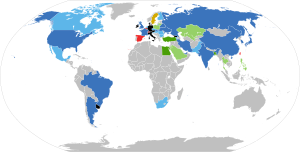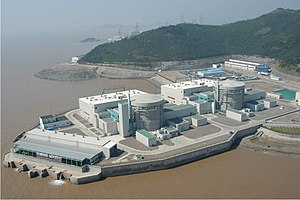A hasty, large-scale movement away from nuclear power would not resolve most of the issues raised by the ongoing crisis in Japan. Instead, we need more thoughtful discussions now about the energy systems of the future.
strategy+business magazineby Tom Flaherty, Joe van den Berg, and Nicolas Volpicelli
Within a few days of a tsunami striking Japan’s Fukushima Daiichi nuclear reactors on March 11, a fierce debate had been fueled about the implications for energy policies around the world. … Unfortunately, we will hear many such oversimplified, rhetorically heated arguments in the weeks and months to come.
 Image via WikipediaAs of April 2011, any debate about the implications of this crisis for the energy industry is premature. It will take into the summer to gather enough facts about the incident to draw reasonable conclusions about the safety and operating practices at this facility — and several more months to establish how those findings should apply to other nuclear plants and other countries. …
Image via WikipediaAs of April 2011, any debate about the implications of this crisis for the energy industry is premature. It will take into the summer to gather enough facts about the incident to draw reasonable conclusions about the safety and operating practices at this facility — and several more months to establish how those findings should apply to other nuclear plants and other countries. …Accepting the Source as Essential
Any sober analysis of the global energy situation would have to conclude that nuclear power is an essential fuel source for many geographies. In a growing global economy, new advances in other forms of energy generation are not sufficient to keep pace with demand, especially if there is a consensus that coal generation should be reduced. …In many countries, a long-term shift away from coal to lower-emission fossil fuels and some renewables is in progress; this shift has already brought environment-related protests over natural gas drilling, changes in land use, and higher power prices. … But, at least for now, they can only contribute to meeting demand; they cannot supplant current sources. … Widespread use of renewables will require dramatic technological developments in energy storage and production, which are not currently available or even foreseeable in the near term.
That leaves traditional fossil fuels, such as coal, gas, and oil. … it is not clear whether available oil and natural gas resources will be sufficient to meet the world’s growing demand for transportation or electricity. In addition, in the developed world, a significant amount of coal generation is slated to be retired during the next 10 years, because of aging facilities and relative inefficiency, which further exacerbates future supply gaps….
 Image via Wikipedia… Though nuclear energy currently makes up only 15 percent of electricity generation worldwide, it constitutes 20 to 30 percent of the energy supply in the U.S., Japan, and Germany, and 75 percent in France. If these countries, and others that rely partially on nuclear power, decide that it should not be part of their long-term energy mix, they will need to engage in challenging and broad new efforts in pursuit of other forms of energy generation. …
Image via Wikipedia… Though nuclear energy currently makes up only 15 percent of electricity generation worldwide, it constitutes 20 to 30 percent of the energy supply in the U.S., Japan, and Germany, and 75 percent in France. If these countries, and others that rely partially on nuclear power, decide that it should not be part of their long-term energy mix, they will need to engage in challenging and broad new efforts in pursuit of other forms of energy generation. …In short, in every conceivable future, nuclear power is a necessary long-term power source, if only because so many nations count it as part of their short-term portfolio now.
Adaptation and Evolution
How, then, should the energy industry and policymakers adapt after Fukushima Daiichi? First, the public will certainly place a high burden of proof on the industry to demonstrate that nuclear reactors will stand up to human-induced catastrophes or unavoidable forces of nature more effectively — even extraordinary “black swan” events like the tsunami that struck Japan. …… Both government regulators and the industry should be prepared to improve plant designs and operating protocols still further, with the aim of strengthening long-term safety and reliability. Industry participants need to step back and approach self-assessment and public scrutiny with an open mind, as a welcome step toward an even safer operating environment and thus a more secure long-term industry. …
 Image via WikipediaTransparency will be a major factor in gaining acceptance. …Policymakers and regulators will need to emphasize solutions that genuinely advance the state of industry performance and reduce risk, rather than simply layer on new requirements with dubious safety and public benefits.
Image via WikipediaTransparency will be a major factor in gaining acceptance. …Policymakers and regulators will need to emphasize solutions that genuinely advance the state of industry performance and reduce risk, rather than simply layer on new requirements with dubious safety and public benefits.Where possible, safety reviews should accelerate a shift to newer technologies. … It will still take several years to bring new plants online, and all existing power sources will be needed in the meantime — …. Conversely, if the crisis results in a slowdown in new nuclear plant construction, it could paradoxically result in extending the operating lives of older plants.
For the long term, countries will need to intensify emerging energy technology research and development. …
… No matter what specific technical outcome emerges, increased investment in nuclear safety will increase the costs of capital investment and operations. … The cost of investing in increased safety will probably force energy prices somewhat higher, but not nearly as high as would a wholesale shift away from nuclear power. …
One potential positive legacy of this situation — a way to commemorate those who have been personally affected by it — would be a comprehensive and thoughtful energy policy that would align government objectives, industry development, and consumer impact. Such a result is going to require more tempered and extended conversation than the current debate has elicited. Instead of arguing for immediate advantage, energy advocates and industry leaders have a chance to think pragmatically about the future. Crises have sometimes led to breakthroughs in capability. Is there some similar possibility here? If so, it must include a recognition of the platform that nuclear power provides for the world’s economy already — and all the ways in which the world’s energy mix needs to develop over the next 15 to 20 years.
Author Profiles:
- Tom Flaherty is a senior partner with Booz & Company based in Dallas. He works with clients in the electric and gas sectors.
- Joe van den Berg is a partner with Booz & Company based in Washington, D.C., who focuses on strategic opportunities available to energy companies.
- Nicolas Volpicelli is a principal with Booz & Company based in Florham Park, N.J., who works with the aerospace and defense industries. Previously, he served with the U.S. Navy as a first lieutenant and reactor propulsion division officer.
- Also contributing to this article was Booz & Company Senior Associate Owen Ward







No comments:
Post a Comment